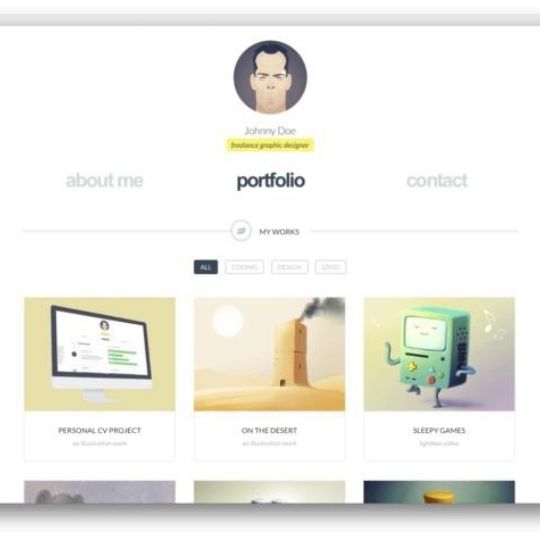Portfolio creation is clearly one of the most important yet feared stages of every creator’s career life.
Creating your portfolio is not usually easy because the pickiest critic to see it first will be you.

And that’s when you start having doubts, feeling lost, and not knowing where to start.
Having a good portfolio is essential because, in the end, it opens the door to a vast commercial world, allowing you to connect with your first (or new) clients and generate business opportunities.
In essence, the portfolio should be more than a compilation of work, but a place where you showcase your work results, skills, and the experiences that have led you to be the professional you are today.
Have you ever tried to create a portfolio? Was it attractive enough to bring you orders?
No worries if not, as this article will show you some essential tips that you can apply to create your portfolio no matter what you do.
- Showcase only Your Best Work Examples
It may not be the first time you read it, but it’s still important to remember: include only the best examples of your work.
Don’t be tempted to include projects as filler because it can be counterproductive and confuse your future clients.
If you have any doubts about the project, it’s better to leave it outside your portfolio.
This is where quality is more important than quantity, so having a few top-notch works is way better than a dozen mediocre ones.
And their arrangement also matters a lot.
Experts recommend placing your two best works at the beginning and end to create positive expectations when they start and leave a good impression when they finish.
If you’d like to see a good example of decent ways of presentation, look at this paper writer service and its Examples page.
There might be way more academic works they have ever produced, but they only showcase the most attractive topics and samples.
And just like the last paragraph said, they open and close the list with their best works to appeal to the customers.
- Tell your story
A portfolio should not only reflect your best work, but it should also talk about you: who you are, how you work, what is your professional experience, what your concerns are, and so on.
Your presentation page with all the info about you should be well-written so that any visitor of your portfolio gets the idea about you without even previously talking to you.
Humanized portfolios attract more people.
It can also be a good idea to introduce yourself on the main page of your portfolio.
No need for long paragraphs, but one or two sentences may be enough to give a bit of context about who you are and what you do.
However, try to be original and avoid generic phrases that don’t add anything new.
- Show your personality
For many people, your portfolio will be the first contact they have with you, so your page should reflect your personality as a creator.
Keep this in mind when making decisions, such as the tone you will use, the font, the color palette, etc.
Show your creativity throughout the portfolio with these elements and create the desired impression of your style and taste.
But remember: overuse of crazy decorations is unprofessional, so keep it calm and pleasant, alright?
- Include feedback
Telling your personal story is great, but another way to generate confidence in the person who sees your portfolio is to let others share their experience of working with you.
That’s why it can be a good idea to include a client feedback section where you show some recommendations from clients who have worked with you.
Here it’s time to be strategic. Try to get these comments from your most valuable clients (famous brands, well-known professionals, etc.) because their authority argument will go in your favor.
- Keep it up to date
One of the most common mistakes among creative industry workers is creating a portfolio and forgetting about it completely.
Normally day-to-day life takes us ahead, and we tend to leave our work for the last, but you must still plan and take some time out periodically to update your page with new achievements or work samples.
Besides, any creator is learning with every new job, and it helps them evolve as a specialist: have you ever had a feeling that a piece you created several years ago does not feel as good and satisfying as it was back in those days?
Reviewing your portfolio will also allow you to have it reflect only on the current state of your skills to attract more high-level customers.
- Choose the right format
Normally all portfolios have at least four basic sections: the home page, the project showcase page, the biography, and the contact.
But when it comes to the showcase page, its appearance depends a lot on what you do: showing video projects is not the same as showing graphic or web design, illustration, animation, or copywriting projects. The amount of creative work types is overwhelming, so how does one choose the best way to demonstrate them?

If you are in doubt, try visiting other people’s portfolios and take notes on how they present their works.
There is nothing bad in taking a look at others’ content arrangement ideas to come up with your own.
This will stop you from being faced with a blank sheet of paper and familiarize you with some common standards of portfolio presentation.
- Make it look professional and user-friendly
Your portfolio should mainly be focused on your work, so the design must not divert attention from what is really important.
Get rid of unnecessary images and pages, and add only the essential information you want your potential clients to know about you and your projects.
Think of your portfolio as a museum or a CV: try to make it minimalist and user-friendly, and let your projects be the main priority.
Ultimately, it’s all about making it easy for your visitors to discover what you do in the best possible way.
- Clearly show your contacts
You’d be surprised how many creators forget to add their contacts or hide them too much while having outstanding portfolios that motivate the clients to collaborate.
Once you have conquered the visitor with your work, you have to make it easy for them to contact you.
Including a separate ‘contact me’ section is great, but you can also add other calls to action throughout the portfolio (in the biography page or the footer) to make sure your future clients always get in touch with you.



